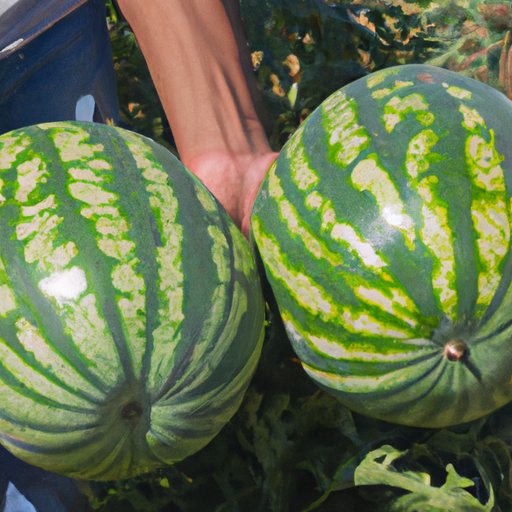I. Introduction
Have you ever been disappointed after cutting into a watermelon only to find it tasteless and dry? Picking the perfect watermelon can be a challenge, especially if you don’t know what to look for. But with a few tips and tricks, you can ensure that every watermelon you bring home is juicy, sweet, and delicious.
In this article, we’ll cover everything you need to know about picking the perfect watermelon. From the science behind the sweetness to the art of selecting a ripe melon, we’ve got you covered. So let’s get started!

II. 7 Tips for Picking the Perfect Watermelon
Before we dive into how to choose the sweetest watermelon or select the ripest one, let’s go over some general tips for picking a good one:
A. Look for the field spot
Watermelons have a yellowish spot on one side where they sat on the ground and ripened in the sun. This spot indicates the ripeness of the fruit. Look for watermelons with a creamy yellow or canary yellow field spot. Avoid those with a white or green spot, as they may not be ripe enough.
B. Check the sound of the watermelon
Give the watermelon a tap or a thump. A ripe watermelon should have a deep, hollow sound. If the sound is dull or flat, it may be underripe or overripe.
C. Examine the watermelon’s shape
A watermelon’s shape can also indicate whether it’s ripe or not. Look for a watermelon that’s symmetrical and uniform in shape. If it’s lopsided or misshapen, it may have ripened unevenly.
D. Look for sugar spots on the watermelon
Sugar spots are the rough, sugary patches that appear on some watermelons. These spots indicate that the fruit is sweet and ripe. More sugar spots mean sweeter fruit.
E. Check the color of the watermelon’s rind
Choose a watermelon with a rind that’s dark green and dull, rather than shiny. A shiny rind can indicate an underripe melon.
F. Inspect the watermelon’s texture and weight
Run your hand over the watermelon’s rind. It should feel slightly bumpy, indicating that the flesh is firm and dense. A heavy watermelon is also a good sign that it’s ripe and juicy, as watermelons are over 90% water.
G. Take note of the watermelon’s size
Size doesn’t necessarily indicate the ripeness or sweetness of a watermelon, but it can be helpful in choosing the right one for your needs. If you need a lot of fruit, choose a larger watermelon. If you’re only feeding a few people, a smaller one will do.
III. How to Choose the Sweetest Watermelon
Now that we’ve covered some general tips for picking a good watermelon, let’s take a closer look at how to choose the sweetest one.
A. Look for uniformity in color
The color of a watermelon’s flesh can indicate its sweetness. Look for watermelons with deep-red, uniform flesh. Avoid those with white streaks or greenish-white flesh, as they may not be sweet enough.
B. Check the sugar content
The sugar content of a watermelon can be determined by its Brix level. Look for watermelons with a Brix level of at least 10. The higher the Brix level, the sweeter the watermelon.
C. Feel for smooth skin
The skin of a watermelon should be smooth, without any soft spots or dents. A bumpy skin can indicate an overripe or mushy watermelon.
D. Choose a watermelon with a dull appearance
A dull rind can indicate a ripe and sweet watermelon, while a shiny rind can indicate an underripe one.
E. Notice the stripes
Watermelons have stripes on their rind. Look for watermelons with stripes that are a consistent width. If the stripes are wider at one end than the other, the watermelon may not have ripened evenly.
IV. The Art of Selecting Ripe Watermelon
Choosing a ripe watermelon is more of an art than a science, but here are a few tips to help you master it:
A. Check the field spot
As we mentioned earlier, the field spot can indicate the ripeness of a watermelon. Look for watermelons with a creamy yellow or canary yellow field spot.
B. Look for a symmetrical shape
Choose a watermelon that’s uniform in shape and symmetrical. An uneven shape can indicate uneven ripening.
C. Check the tendril nearest the melon
Watermelons have tendrils or curly green stems near the fruit. If the tendril is brown and dry, the watermelon may be ripe. If the tendril is green and plump, the watermelon may still be ripening.
D. Examine the watermelon’s weight
A ripe watermelon will feel heavy for its size. This is because it’s full of water, making it dense and heavy.
V. The Science Behind Choosing the Best Watermelon
Choosing the perfect watermelon involves both art and science. Here are a few scientific factors to consider:
A. How to determine sweetness based on the sugar content
We mentioned earlier that the Brix level can indicate a watermelon’s sweetness. Brix is a measure of the amount of sugar in a fruit or vegetable. To measure a watermelon’s Brix level, use a refractometer, which is available at most garden stores.
B. The role of lycopene in a watermelon’s taste
Lycopene is a pigment that gives red fruits and vegetables their color. It also contributes to their taste and nutritional value. Watermelons are high in lycopene, which is why they’re sweet and juicy.
C. How to choose a ripe watermelon based on its aroma
Watermelons have a distinct aroma when they’re ripe. Sniff the stem end of the watermelon. If it smells sweet and fruity, it’s likely ripe. If it doesn’t smell like anything, it may not be ready yet.
VI. Mastering the Art of Watermelon Picking
Now that you know the science and art of selecting the perfect watermelon, here are a few additional tips to help you master the craft:
A. Pay attention to the season
The best time to buy watermelons is in the summer when they’re in season. They’ll be at their freshest and most flavorful.
B. Know the various types and varieties of watermelons
Watermelons come in many different types and varieties. Each has its own unique flavor profile and characteristics. Some popular types include seedless, mini, and yellow watermelons.
C. Shop at a local farmer’s market
Local farmer’s markets are a great place to find fresh, locally grown watermelons. The farmers can also provide advice on how to pick the perfect one.
D. Try the thump test
While not foolproof, the thump test can be a helpful way to determine the ripeness of a watermelon. Give the watermelon a tap or a thump with your knuckles. A ripe watermelon should have a deep, hollow sound.
VII. The Top 7 Factors to Consider When Picking Watermelon
To summarize, here are the top seven factors to consider when picking watermelon:
A. Weight
A ripe watermelon will be heavy for its size.
B. Shape
Look for a watermelon that’s symmetrical and uniform in shape.
C. Color
The color of the flesh and the rind can indicate the ripeness and sweetness of the fruit.
D. Sound
A ripe watermelon will have a deep, hollow sound when tapped or thumped.
E. Texture
The skin should be smooth, and the flesh should be firm and dense.
F. Size
Choose a watermelon that’s the right size for your needs.
G. Aroma
Sniff the stem end of the watermelon to determine if it’s ripe.
VIII. A Guide to Picking a Juicy and Sweet Watermelon
To recap, here are some tips and tricks to help you pick a juicy and sweet watermelon:
- Look for a creamy yellow or canary yellow field spot.
- Gently tap or thump the watermelon to check the sound.
- Choose a symmetrical and uniform watermelon.
- Look for sugar spots and deep-red, uniform flesh.
- Choose a dull and uniform rind.
- Run your hand over the rind to feel for firmness and density.
- Choose a watermelon that’s the right size for your needs.
In addition to these tips, pay attention to the season, know the various types and varieties of watermelons, and try shopping at a local farmer’s market. And don’t forget to give the watermelon a sniff!
IX. Conclusion
Picking the perfect watermelon doesn’t have to be difficult. By following these tips and tricks, you can ensure that every watermelon you bring home is sweet, juicy, and delicious. We hope this guide has been helpful in mastering the art and science of watermelon picking.
